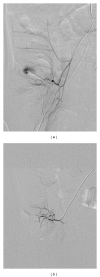Treatment of nonvariceal gastrointestinal hemorrhage by transcatheter embolization
- PMID: 23844289
- PMCID: PMC3697786
- DOI: 10.1155/2013/604328
Treatment of nonvariceal gastrointestinal hemorrhage by transcatheter embolization
Abstract
Purpose. To investigate the sensitivity of mesenteric angiography, technical success of hemostasis, clinical success rate, and complications of transcatheter embolization for the treatment of acute nonvariceal gastrointestinal hemorrhage. Material and Methods. A retrospective review of 200 consecutive patients who underwent mesenteric arteriography for acute nonvariceal gastrointestinal hemorrhage between February 2004 and February 2011 was done. Results. Of 200 angiographic studies, 114 correctly revealed the bleeding site with mesenteric angiography. 47 (41%) patients had upper gastrointestinal hemorrhage and 67 (59%) patients had lower gastrointestinal hemorrhage. Out of these 114, in 112 patients (98%) technical success was achieved with immediate cessation of bleeding. 81 patients could be followed for one month. Clinical success was achieved in 72 out of these 81 patients (89%). Seven patients rebled. 2 patients developed bowel ischemia. Four patients underwent surgery for bowel ischemia or rebleeding. Conclusion. The use of therapeutic transcatheter embolization for treatment of acute gastrointestinal hemorrhage is highly successful and relatively safe with 98% technical success and 2.4% postembolization ischemia in our series. In 89% of cases it was definitive without any further intervention.
Figures


References
-
- Palmer K. Acute upper gastrointestinal haemorrhage. British Medical Bulletin. 2007;83(1):307–324. - PubMed
-
- Charbonnet P, Toman J, Bühler L, et al. Treatment of gastrointestinal hemorrhage. Abdominal Imaging. 2005;30(6):719–726. - PubMed
-
- D’Othée BJ, Surapaneni P, Rabkin D, Nasser I, Clouse M. Microcoil embolization for acute lower gastrointestinal bleeding. CardioVascular and Interventional Radiology. 2006;29(1):49–58. - PubMed
-
- Tan K-K, Wong D, Sim R. Superselective embolization for lower gastrointestinal hemorrhage: an institutional review over 7 years. World Journal of Surgery. 2008;32(12):2707–2715. - PubMed
LinkOut - more resources
Full Text Sources
Other Literature Sources

